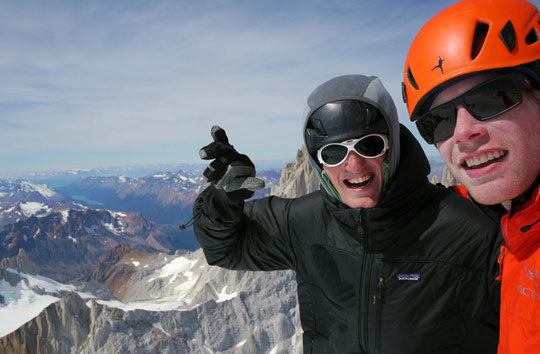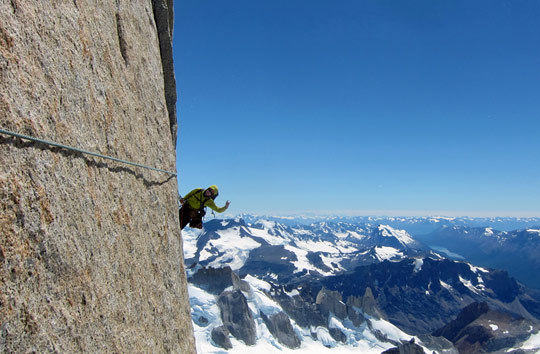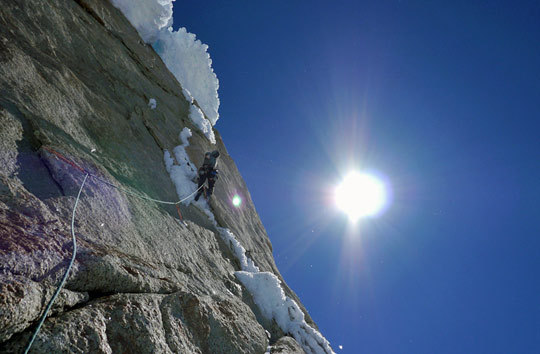
Hayden Kennedy and Jason Kruk on the summit of Cerro Torre after climbing their 5.11 A2 variation of the Compressor Route, just before removing the bolts from the upper pitches of the Compressor Route. [Photo] Jason Kruk
The following is a Press Release from Hayden Kennedy and Jason Kruk, regarding their Cerro Torre ascent. – Keese Lane, Alpinist Online Editor
“As a society we have removed other mistakes, like the Berlin Wall.
History doesn’t stop. History is happening right now. Hopefully the
bolts are history someday.” – Zach Smith
If you are lucky enough to catch a glimpse of Cerro Torre on a rare,
clear day, you will understand why many consider it the most beautiful
and compelling mountain in the world. Messner called it ‘a shriek
turned to stone’. The contradiction between its great beauty and its
intimidating aspects will make the head spin of any enterprising
climber wanting to one day try it.
In mid January, 2012, Hayden Kennedy and I completed the defining
climb of our collective careers. But, the mountain and our route have
been betrayed by the unfortunate controversy that enshrouds it like
the clouds.
We agreed to meet in El Chalten, the gateway town to the range, in
early December 2011. In the month leading up to our trip, Hayden and I
hadn’t talked much. He was in Turkey sportclimbing and preoccupied
with a Norwegian girl there. I was in Mexico flying paragliders.
Despite seven seasons of cumulative experience in the range and a
lengthy wish-list, we hadn’t talked about any specific objectives
other than wanting to ‘climb on the Torres’ and do it in our favorite
style – fast, light, and as free as can be. We knew the best laid
plans would likely be scattered by the Patagonian winds. Better to be
adaptable and simply go with the flow. We have always been on the same
page, climbing wise, since our first time tying in together a couple
years ago. That was at the base of Cerro Fitz Roy which we climbed via
a Patagonian classic, the Supercanaleta (1600m 6a+ 85 degrees), a route that
on the first ascent was a high water mark of climbing style. It was
completed in 1965 by Argentine climbers Carlos Comesana and Jose Luis
Fonrouge in perfect alpine style over a three day round trip, stats
very impressive by even modern standards, infinitely more so
considering the equipment of the time. It was also the second-ever
ascent of Cerro Fitz Roy.
It wasn’t long upon our arrival in El Chalten before the weather
looked good enough for an attempt on something. We chose to climb the
classic Exocet (500m 6a WI5 MI3), on Aguja Standhardt, the perfect
intro route to the specific nuances of Torre climbing. A week or so
later we climbed Punta Herron via Spigolo dei Bimbi (350m 6b MI5) as
well as the Huber-Schnarf (200m 6b+ MI3), summiting Torre Egger in a
long day camp to camp. In this time we also climbed the classic Chiaro
di Luna on Aguja St. Exupery and established a new route on Aguja de
l’S.
We were certainly fulfilling our plans to ‘climb on the Torres’,
having completed routes on three out of the four. Remaining only was
Cerro Torre, a mountain I had tried to climb the year before. Chris
Geisler and I had reached a point some 40 meters shy of the top of the
headwall. We had attempted the southeast ridge, the line of the
Compressor Route, but had avoided using any of Maestri’s bolts. When
our best guess at the line of weakness up the headwall dead-ended we
had two options: retreat, or continue up the bolt line.
We would not summit the Torre that year. Our attempt was soured by the
reawakening of the Cerro Torre controversy that Chris and I were now
swept up in. Loving the controversy, all the magazines wanted to know
my opinion. The hype became too much – recycled garbage. Eventually I
was tired of it all, the idea of comparing myself to someone else
sickened me. My plan was never to promote my ascent nor defame David
Lama.

Jason Kruk [Photo] Hayden Kennedy
Hayden and I would focus our energy on another line on the Torre this
season: the north face. The wild face is full of adventure and the
unknown. Feeling uber-fit and stoked to the max, we knew we had a shot
if the weather continued to cooperate. However, the month of January
was uncharacteristically warm in the mountains, and attempting the
north face seemed just too dangerous. The most logical line to attempt
was now my old friend the Southeast Ridge.
On the morning of January 15th Hayden and I left Niponino basecamp,
approached Cerro Torre and climbed the 300m mixed ‘approach’ to the
Col of Patience slowly, conserving as much energy as possible. Here we
relaxed in the shade of our tent, and drank and ate as much as
possible. With binoculars, we spied discontinuous features splitting
the very left of the headwall that would possibly connect the line
Geisler and I had attempted with the summit.
We slept through our 11 p.m. alarm, waking at 2 a.m. We pounded coffee, got
psyched, and were climbing by 2:45. Joyous, splitter climbing
comprises the majority of the lower SE Ridge. We hooted and hollered
into the night as we made very quick time in the dark. We reached the
Salvaterra-Mabboni variation just before first light, around 5:00am.
The integral ridgeline above was attempted as early as 1968 and
finally climbed in 1999 by Ermanno Salvaterra and Mauro Mabboni. From
here the Compressor Route beelines inexplicably right, across blank
rock and hundreds of bolts. Hayden led the beautiful A1 splitter crack
above, using a couple knifeblades in between small cams. The climbing
on the ridge above is absolutely brilliant – immaculate 5.10 edges in
an exposed position on the arete. Short-fixing off a two-bolt anchor,
Hayden continued up the arete at top speed while I followed on the
jumars as quickly as possible. I reached the belay, an incredible
position at an apex above the south face, gasping for breath. Looking
right, ice and mixed terrain led through the ice tower features.
Grabbing the rack and changing into crampons, we high-fived and I took
off, navigating the ice and mixed pitches, short-fixing the rope for
Hayden to follow all the way to the base of the WI5 chimney. This
long, steep pitch, first climbed by Josh Wharton and Zack Smith,
bypasses yet another bolt ladder up a blank wall to its right. The ice
was cold, bullet-hard. I ran it out between three ice screws, Hayden
followed. We were at the base of the headwall, elated.
Donning rock shoes, Hayden cast off on the steep ground above. The
first two pitches were comprised of athletic 5.11- climbing over
large, positive flakes. Deviating just right, then left, of the
Compressor bolts, Hayden ran it out between solid cams, commenting on
the bliss of the quality movement in such an extreme environment. Reaching
a mid-way ledge, Hayden free climbed directly left off the belay,
finding free-climbable edges where Chris last year, in a weakened
state, had resorted to techno-aid. From this point Chris had placed a
bolt in a blank section of rock and had climbed right, across a
feature that would eventually deadend on us last year. Hayden reached
the bolt and lowered to the level of my belay. Running back and forth across
the headwall, Hayden stuck an edge at the apex of this King Swing.
More edges led down to a small perch on the immediate left edge of the
headwall. Cleaning the pitch and lowering out off the bolt, I joined
Hayden at this belay stance, a spot so exposed we may as well have
been on the moon.

Hayden Kennedy [Photo] Jason Kruk
Above, discontinuous cracks, edges, and ice blobs provided passage up
perfect red patina granite. Hayden expertly navigated the complex
terrain with a mixture of free and ice climbing. The only aid was in
the name of alpine efficiency – stopping to stand in a sling to chop a
couple cam placements out of iced-up cracks. After another belay,
Hayden, still feeling psyched to lead, lead a brilliant traverse a
stones throw from the top of the headwall, following a magic splitter
crack. The crack dead-ended and Hayden, arms failing from dehydration,
hooked the ultimate moves to the top of the headwall. Hayden started
screaming and I knew it was in the bag. I followed the pitch with a
massive shit-eating grin. We had held our breath till this point,
honestly expecting to be shut down at any moment.
We dropped our gear on the summit snowfield and ran up the final
mushroom to the summit. We had just done the first fair-means ascent
of the Southeast Ridge of Cerro Torre in 13 hours.
There has been a lot of talk over the years about chopping the
Compressor bolts. Undoubtably, it is a lot easier to talk about it
than to actually do it and deal with the consequences. After a lengthy
introspection on the summit, we knew the act needed to be initiated by
one party, without consensus. The tribes will always remain too
polarized to reach a common ground. Of course at cocktail hour in El
Chalten there was much talk of those ‘what ifs’ of climbing the SE
Ridge. Truthfully, during our climb and the days preceding it, Hayden
and I talked nothing of removing the bolts.
Fair means does not mean no bolts. Reasonable use of bolts has been a
long-accepted practice in this mountain range. Often, steep, blank
granite would be folly without the sparing using of this type of
protection. We clipped four bolts placed by Salvaterra on his
variation – two in a belay and two for protection. At that point on
the route, Hayden was short-fixing with a 35 meter loop of slack,
surely a death-fall anyways. He could have clearly skipped them, but
that’s not the point. These bolts were placed in blank granite, by
hand, on otherwise un-protectable terrain. Higher we used the bolt
placed by Chris on our attempt last year. Five bolts for four hundred
seemed like a pretty good trade to us. We also used two of Maestri’s
original belays on the headwall. These were in spots in
close-proximity to other natural anchor options. Believe us, we know
how to build gear anchors. The fact that we were planning on leaving
these bolts in anyways, meant it was too silly not to use them on the
ascent. Our ultimate goal was respect for the mountain. The headwall
rappels could have been chopped and replaced by nuts and pitons.
However, considering that on a beautiful and popular line there will
inevitably be rappel anchors in place, it seemed more logical to leave
the established anchors, rather than remove them, and let the anchors
slowly degrade into the 5 and 6-piece rappel anchors of tattered cord
that are found on other popular routes in the range.
In the end, we removed the bolts on the entire headwall and on one of
the pitches below. Our best guess would count around 125. We would
have continued chopping below, if not for our friends Victor and
Ricardo, dependent on the bolts of the 90-meter bolt traverse to
descend themselves.
The question that remains, is why?
Maestri’s actions were a complete atrocity. His use of bolts and heavy
machinery was outrageous, even for the time. The Southeast Ridge was
attainable by fair means in the ’70s, he stole that climb from the
future.
Cerro Torre, a mountain so perfectly steep on all sides, is the
postcard for the ideal that is alpinism. There should be no easy way
to the top. The fact that there was a glorified via-ferrata to its
summit deeply offended a global community of dedicated alpinists. If
Cerro Torre was any more accessible, someone would have chopped
Maestri’s bolts a long time ago, returning the mountain to its former
grandeur.
Who committed the act of violence against Cerro Torre? Maestri, by
installing the bolts, or us, by removing them?
As long as the hardware remained it was justification for the
unreasonable use of bolts by others. We are part of the next
generation, the young group of aspiring alpinists. This is a statement
we felt other young alpinists needed to hear.
Our real feelings were confirmed by three young Argentine climbers we
passed on the Torre Glacier while hiking out of the range. Their
eyes lit up as they told us how inspired they were to climb on Cerro
Torre now, to train harder, to be better. To rise up to the challenge
that has been restored to the mountain. Two days later they would make
a rare ascent of Aguja Standhardt, via Festerville. Respect.
A bunch of people climbed the Compressor Route and had fun, but now
it’s a new era for Cerro Torre. Days after our ascent, young, talented
Austrian alpinists, David Lama and Peter Ortner free-climbed their own
variation on the Southeast Ridge. This news was greatly inspirational
to Hayden and I, and is further proof that the bolts were unnecessary.
It would be hard to claim more authority than Comesana, who, upon
hearing the news of our actions responded:
“In my name and the others that resign the dream to climb for first
this fantastic mountain I claim for our rights to delete from the
walls of Cerro Torre all the remainings – compressor inclusive – of
the rape made by Maestri in the ’70’s and I think that no one – for any
reason – can have more rights than ours.”
–Jason Kruk, Squamish, BC
–Hayden Kennedy, Carbondale, Colorado

Hayden Kennedy [Photo] Jason Kruk